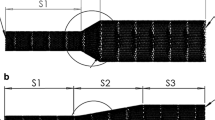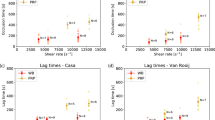Abstract
Particle image velocimetry (PIV) is a commonly used method for in vitro investigation of fluid dynamics in biomedical devices, such as flow diverters for intracranial aneurysm treatment. Since it is limited to transparent blood substituting fluids like water-glycerol mixture, the influence of coagulation and platelet aggregation is neglected. We aimed at the development and the application of a modified platelet rich plasma as a new PIV fluid with blood-like rheological and coagulation properties. In standardized intracranial aneurysm silicone models, the effect of this new PIV plasma on the fluid dynamics before and after flow diverter implantation was evaluated and compared with water-glycerol measurements. The flow diverting effect was strongly dependent on the used fluid, with considerably lower velocities achieved using PIV plasma, despite the same starting viscosity of both fluids. Moreover, triggering coagulation of PIV plasma allowed for intra-aneurysmal clot formation. We presented the first in vitro PIV investigation using a non-Newtonian, clottable PIV plasma, demonstrating a mismatch to a standard PIV fluid and allowing for thrombus formation.





Similar content being viewed by others
References
Augsburger, L., M. Farhat, P. Reymond, E. Fonck, Z. Kulcsar, N. Stergiopulos, and D. A. Rüfenacht. Effect of flow diverter porosity on intraaneurysmal blood flow. Clin. Neuroradiol. 19(3):204–214, 2009.
Becske, T., W. Brinjikji, M. B. Potts, D. F. Kallmes, M. Shapiro, C. J. Moran, E. I. Levy, C. G. McDougall, I. Szikora, G. Lanzino, et al. Long-Term clinical and angiographic outcomes following pipeline embolization device treatment of complex internal carotid artery aneurysms: five-year results of the pipeline for uncoilable or failed aneurysms trial. Neurosurgery 80(1):40–48, 2017.
Bouillot, P., O. Brina, R. Ouared, K.-O. Lovblad, M. Farhat, and V. M. Pereira. Particle imaging velocimetry evaluation of intracranial stents in sidewall aneurysm: hemodynamic transition related to the stent design. PLoS ONE 9(12):e113762, 2014.
Boussel, L., V. Rayz, C. McCulloch, A. Martin, G. Acevedo-Bolton, M. Lawton, R. Higashida, W. S. Smith, W. L. Young, and D. Saloner. Aneurysm growth occurs at region of low wall shear stress. Stroke 39(11):2997–3002, 2008.
Brookshier, K. A., and J. M. Tarbell. Evaluation of a transparent blood analog fluid: aqueous xanthan gum/glycerin. Biorheology 30(2):107–116, 1993.
Cattaneo, G. F. M., A. Ding, T. Jost, D. Ley, R. Mühl-Bennighaus, U. Yilmaz, H. Körner, W. Reith, and A. Simgen. In vitro, contrast agent-based evaluation of the influence of flow diverter size and position on intra-aneurysmal flow dynamics using syngo iFlow. Neuroradiology 59(12):1275–1283, 2017.
Cebral, J. R., F. Mut, M. Raschi, S. Hodis, Y.-H. Ding, B. J. Erickson, R. Kadirvel, and D. F. Kallmes. Analysis of hemodynamics and aneurysm occlusion after flow-diverting treatment in rabbit models. Am. J. Neuroradiol. 35(8):1567–1573, 2014.
Cebral, J. R., F. Mut, M. Raschi, E. Scrivano, R. Ceratto, P. Lylyk, and C. M. Putman. Aneurysm rupture following treatment with flow-diverting stents: computational hemodynamics analysis of treatment. Am. J. Neuroradiol. 32(1):27–33, 2011.
Dorn, F., F. Niedermeyer, A. Balasso, D. Liepsch, and T. Liebig. The effect of stents on intra-aneurysmal hemodynamics: in vitro evaluation of a pulsatile sidewall aneurysm using laser Doppler anemometry. Neuroradiology 53(4):267–272, 2011.
Evans, R. L., R. B. Kirkwood, and D. G. Opsahl. The dynamic viscosity of some human blood. Biorheology 8(3–4):125–128, 1971.
Gester, K., I. Lüchtefeld, M. Büsen, S. J. Sonntag, T. Linde, U. Steinseifer, and G. Cattaneo. In vitro evaluation of intra-aneurysmal, flow-diverter-induced thrombus formation: a feasibility study. Am. J. Neuroradiol. 37(3):490–496, 2016.
Jansen, S. V., I. Müller, M. Nachtsheim, T. Schmitz-Rode, and U. Steinseifer. Ghost cell suspensions as blood analogue fluid for macroscopic particle image velocimetry measurements. Artif. Organs 40(2):207–212, 2016.
Ley, D., R. Mühl-Benninghaus, U. Yilmaz, H. Körner, G. F. M. Cattaneo, W. Mailänder, Y. J. Kim, B. Scheller, W. Reith, and A. Simgen. The Derivo embolization device, a second-generation flow diverter for the treatment of intracranial aneurysms, evaluated in an elastase-induced aneurysm model. Clin. Neuroradiol. 27(3):335–343, 2015.
Lieber, B. B., V. Livescu, L. N. Hopkins, and A. K. Wakhloo. Particle image velocimetry assessment of stent design influence on intra-aneurysmal flow. Ann. Biomed. Eng. 30(6):768–777, 2002.
Liou, T.-M., S.-N. Liou, and K.-L. Chu. Intra-aneurysmal flow with helix and mesh stent placement across side-wall aneurysm pore of a straight parent vessel. J. Biomech. Eng. 126(1):36–43, 2004.
Perlo, J., E. V. Silletta, E. Danieli, G. Cattaneo, R. H. Acosta, B. Blümich, and F. Casanova. Desktop MRI as a promising tool for mapping intra-aneurismal flow. Magn. Reson. Imaging 33(3):328–335, 2015.
Pumar, J. M., A. Banguero, H. Cuellar, L. Guimaraens, J. Masso, S. Miralbes, M. Blanco-Ulla, F. Vazquez-Herrero, M. Souto, and M. Gelabert-Gonzalez. Treatment of intracranial aneurysms with the SILK embolization device in a multicenter study. A retrospective data analysis. Neurosurgery 81(4):595–601, 2017.
Rayz, V. L., L. Boussel, L. Ge, J. R. Leach, A. J. Martin, M. T. Lawton, C. McCulloch, and D. Saloner. Flow residence time and regions of intraluminal thrombus deposition in intracranial aneurysms. Ann. Biomed. Eng. 38(10):3058–3069, 2010.
Rudin, S., Z. Wang, I. Kyprianou, K. R. Hoffmann, Y. Wu, H. Meng, L. R. Guterman, B. Nemes, D. R. Bednarek, and J. Dmochowski. Measurement of flow modification in phantom aneurysm model: comparison of coils and a longitudinally and axially asymmetric stent—initial findings. Radiology 231(1):272–276, 2004.
Shojima, M., M. Oshima, K. Takagi, R. Torii, M. Hayakawa, K. Katada, A. Morita, and T. Kirino. Magnitude and role of wall shear stress on cerebral aneurysm. Stroke 35(11):2500–2505, 2004.
Xiang, J., S. K. Natarajan, M. Tremmel, D. Ma, J. Mocco, L. N. Hopkins, A. H. Siddiqui, E. I. Levy, and H. Meng. Hemodynamic–morphologic discriminants for intracranial aneurysm rupture. Stroke 42(1):144–152, 2011.
Acknowledgments
This work was supported by the German Federal Ministry for Economic Affairs and Energy, Grant No. KF2335806AJ4. The authors thank the Department of Biochemical Engineering of the Aachener VerfahrensTechnik (AVT) Institute for the use of the rheometer.
Author information
Authors and Affiliations
Corresponding author
Additional information
Associate Editor Sriram Neelamegham oversaw the review of this article.
Electronic supplementary material
Below is the link to the electronic supplementary material.
Rights and permissions
About this article
Cite this article
Clauser, J., Knieps, M.S., Büsen, M. et al. A Novel Plasma-Based Fluid for Particle Image Velocimetry (PIV): In-Vitro Feasibility Study of Flow Diverter Effects in Aneurysm Model. Ann Biomed Eng 46, 841–848 (2018). https://doi.org/10.1007/s10439-018-2002-1
Received:
Accepted:
Published:
Issue Date:
DOI: https://doi.org/10.1007/s10439-018-2002-1




